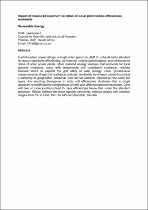 ResearchSpace
ResearchSpace
Impact of measured spectrum variation on solar photovoltaic efficiencies worldwide
JavaScript is disabled for your browser. Some features of this site may not work without it.
- ResearchSpace
- →
- Research Publications/Outputs
- →
- Conference Publications
- →
- View Item
| dc.contributor.author |
Kinsey, GS

|
|
| dc.contributor.author |
Riedel-Lyngskær, NC

|
|
| dc.contributor.author |
Miguel, A

|
|
| dc.contributor.author |
Boyd, M

|
|
| dc.contributor.author |
Braga, M

|
|
| dc.contributor.author |
Shou, C

|
|
| dc.contributor.author |
Cordero, RR

|
|
| dc.contributor.author |
Duck, BC

|
|
| dc.contributor.author |
Maweza, Elijah L

|
|
| dc.contributor.author |
Pratt, Lawrence E

|
|
| dc.date.accessioned | 2022-09-05T06:48:22Z | |
| dc.date.available | 2022-09-05T06:48:22Z | |
| dc.date.issued | 2022-08 | |
| dc.identifier.citation | Kinsey, G., Riedel-Lyngskær, N., Miguel, A., Boyd, M., Braga, M., Shou, C., Cordero, R. & Duck, B. et al. 2022. Impact of measured spectrum variation on solar photovoltaic efficiencies worldwide. <i>Renewable Energy, 196.</i> http://hdl.handle.net/10204/12488 | en_ZA |
| dc.identifier.issn | 1879-0682 | |
| dc.identifier.issn | 0960-1481 | |
| dc.identifier.uri | https://doi.org/10.1016/j.renene.2022.07.011 | |
| dc.identifier.uri | http://hdl.handle.net/10204/12488 | |
| dc.description.abstract | In photovoltaic power ratings, a single solar spectrum, AM1.5, is the de facto standard for record laboratory efficiencies, commercial module specifications, and performance ratios of solar power plants. More detailed energy analysis that accounts for local spectral irradiance, along with temperature and broadband irradiance, reduces forecast errors to expand the grid utility of solar energy. Here, ground-level measurements of spectral irradiance collected worldwide have been pooled to provide a sampling of geographic, seasonal, and diurnal variation. Applied to nine solar cell types, the resulting divergence in solar cell efficiencies illustrates that a single spectrum is insufficient for comparisons of cells with different spectral responses. Cells with two or more junctions tend to have efficiencies below that under the standard spectrum. Silicon exhibits the least spectral sensitivity: relative weekly site variation ranges from 1% in Lima, Peru to 14% in Edmonton, Canada. | en_US |
| dc.format | Abstract | en_US |
| dc.language.iso | en | en_US |
| dc.relation.uri | https://www.sciencedirect.com/science/article/pii/S0960148122010072 | en_US |
| dc.source | Renewable Energy, 196 | en_US |
| dc.subject | Energy yield | en_US |
| dc.subject | Forecasting | en_US |
| dc.subject | Photovoltaics | en_US |
| dc.subject | Spectral irradiance | en_US |
| dc.title | Impact of measured spectrum variation on solar photovoltaic efficiencies worldwide | en_US |
| dc.type | Article | en_US |
| dc.description.pages | 995-1016 | en_US |
| dc.description.note | © 2022 Elsevier Ltd. All rights reserved. Due to copyright restrictions, the attached PDF file only contains the abstract of the full text item. For access to the full text item, please consult the publisher's website: https://www.sciencedirect.com/science/article/pii/S0960148122010072 | en_US |
| dc.description.cluster | Smart Places | en_US |
| dc.description.impactarea | Energy Supply and Demand | en_US |
| dc.identifier.apacitation | Kinsey, G., Riedel-Lyngskær, N., Miguel, A., Boyd, M., Braga, M., Shou, C., ... Pratt, L. E. (2022). Impact of measured spectrum variation on solar photovoltaic efficiencies worldwide. <i>Renewable Energy, 196</i>, http://hdl.handle.net/10204/12488 | en_ZA |
| dc.identifier.chicagocitation | Kinsey, GS, NC Riedel-Lyngskær, A Miguel, M Boyd, M Braga, C Shou, RR Cordero, BC Duck, Elijah L Maweza, and Lawrence E Pratt "Impact of measured spectrum variation on solar photovoltaic efficiencies worldwide." <i>Renewable Energy, 196</i> (2022) http://hdl.handle.net/10204/12488 | en_ZA |
| dc.identifier.vancouvercitation | Kinsey G, Riedel-Lyngskær N, Miguel A, Boyd M, Braga M, Shou C, et al. Impact of measured spectrum variation on solar photovoltaic efficiencies worldwide. Renewable Energy, 196. 2022; http://hdl.handle.net/10204/12488. | en_ZA |
| dc.identifier.ris | TY - Article AU - Kinsey, GS AU - Riedel-Lyngskær, NC AU - Miguel, A AU - Boyd, M AU - Braga, M AU - Shou, C AU - Cordero, RR AU - Duck, BC AU - Maweza, Elijah L AU - Pratt, Lawrence E AB - In photovoltaic power ratings, a single solar spectrum, AM1.5, is the de facto standard for record laboratory efficiencies, commercial module specifications, and performance ratios of solar power plants. More detailed energy analysis that accounts for local spectral irradiance, along with temperature and broadband irradiance, reduces forecast errors to expand the grid utility of solar energy. Here, ground-level measurements of spectral irradiance collected worldwide have been pooled to provide a sampling of geographic, seasonal, and diurnal variation. Applied to nine solar cell types, the resulting divergence in solar cell efficiencies illustrates that a single spectrum is insufficient for comparisons of cells with different spectral responses. Cells with two or more junctions tend to have efficiencies below that under the standard spectrum. Silicon exhibits the least spectral sensitivity: relative weekly site variation ranges from 1% in Lima, Peru to 14% in Edmonton, Canada. DA - 2022-08 DB - ResearchSpace DP - CSIR J1 - Renewable Energy, 196 KW - Energy yield KW - Forecasting KW - Photovoltaics KW - Spectral irradiance LK - https://researchspace.csir.co.za PY - 2022 SM - 1879-0682 SM - 0960-1481 T1 - Impact of measured spectrum variation on solar photovoltaic efficiencies worldwide TI - Impact of measured spectrum variation on solar photovoltaic efficiencies worldwide UR - http://hdl.handle.net/10204/12488 ER - | en_ZA |
| dc.identifier.worklist | 25983 | en_US |





